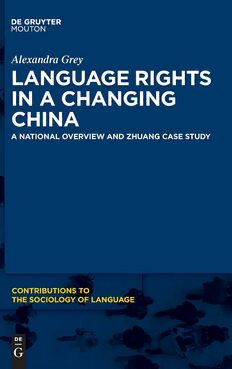
Language Rights in a Changing China: A National Overview and Zhuang Case Study PDF
Preview Language Rights in a Changing China: A National Overview and Zhuang Case Study
AlexandraGrey LanguageRightsinaChangingChina Contributions to the Sociology of Language Edited by Ofelia García Francis M. Hult Founding editor Joshua A. Fishman Volume 113 Alexandra Grey Language Rights in a Changing China A National Overview and Zhuang Case Study ISBN978-1-5015-1774-7 e-ISBN(PDF)978-1-5015-1255-1 e-ISBN(EPUB)978-1-5015-1240-7 ISSN1861-0676 LibraryofCongressControlNumber:2020952711 BibliographicinformationpublishedbytheDeutscheNationalbibliothek TheDeutscheNationalbibliothekliststhispublicationintheDeutscheNationalbibliografie; detailedbibliographicdataareavailableontheInternetathttp://dnb.dnb.de. ©2021WalterdeGruyterInc.,Boston/Berlin Coverimage:sculpies/shutterstock Typesetting:IntegraSoftwareServicesPvt.Ltd. Printingandbinding:CPIbooksGmbH,Leck www.degruyter.com InmemoryofHannahYiu. Preface In my journey to a research problem centered on languages in the South of China, I gathered many photographs of places and people. The small selec- tion in Figures 1 to 3, all from cities in the Guangxi Zhuangzu Autonomous Region (GZAR) in South China, indicate how everyday urban streetscapes and associated language practices in China have changed since the middle of the twentieth century. Moreover, the obvious changes in public, urban life revealed in these photographs hint at potentially significant changes in linguistic, social and cultural spheres of life that photographs cannot cap- ture. What language varieties did the photographed soldiers, pedestrians and cyclists use? How did their language practices, and views about them, change along with the enormous transformations in Chinese society during this time? Figure1:Urbanmainstreet,unspecifiedcityinGZAR,circa1940sfrom(LiandGZARAreal AnnalsCompilationCommittee2010:308,withthankstoparticipant“MrS”). OneofthetransformationsevidentinthesephotographsistheadditionofEnglish onsignagebythetwenty-firstcentury,whilewrittenMandarinisafixtureacross https://doi.org/10.1515/9781501512551-202 VIII Preface Figure2:Photographscaptioned“MainstreetofKweilin[Guilin]”,GZAR,1976,photographed bytheauthor’smother,reprintedwithpermission. Figure3:AmainstreetofGuilin,GZAR,2015,photographedbytheauthorduringfieldwork. the span of these photographs. However, the photographs show a striking ab- senceofZhuanglanguage.ZhuanglanguageisaTailanguage–notaMandarin language–anditwasconsideredsowidelyspokenanddefiningofethnicitythat the Zhuangzu minority group was recognized by the People’s Republic of China (PRC) government and named after the language in the early 1950s. Then the Guangxi Zhuangzu Autonomous Region was namedafter – and for – this group in 1958. (NB. I use ‘the PRC’ instead of China only whenI need to disambiguate thecurrentnationfromitsforebears.)Moreover,thisareawaswheretheZhuang Preface IX dialectsoriginated.YetZhuangdoesnotappearonanyofthesignsinthesepho- tographs. Rather, in the pre-communist era shown in Figure 1, public texts are prevalent in the urban streetscape, mostly commercial slogans in Mandarin exclusively using traditional characters. In the 1970s (Figure 2), by contrast, largesignageseemsabsentfromastreetscapedesignedforpedestrians,cyclists andminimalcommerce.Thesmallsignsthatarevisibleontherightinthispho- tograph are written in simplified Mandarin characters; many are indistinct but on close inspection, one says 拉链 (zipper) i.e. a repair shop. Nowadays, as Figure3shows,amixtureoflargecommercialandorientationtexts,designedto be visible to motorists, dominate the urban streetscape. In addition to the Mandarin insimplified characterson thiscontemporarysignage,the Roman al- phabetnowalsohasavisiblepresence,usedbothforEnglishandastheofficial auxiliaryPinyinscriptfor the national language, Putonghua (officially standard- izedMandarin). Thesesimpleobservationspointtoanintriguinginterplaybetweenlanguage practicesandpoliticalandeconomictransformations.Moreover,asnotedbythe renownedcontemporarysociolinguist,MonicaHeller(2003:473),changesrelat- ingtoeconomicglobalizationinthelatetwentiethcenturyareinseparablefrom transformations to languages and identities. Economic globalization reached China–orrather,Chinalauncheditselfintoeconomicglobalization–after1978. Thisglobalizedandstillglobalizingcontextoughtthereforebeaninseparablepart ofmyresearchintolanguageandidentityinChina. Hellergoesontomakethepointthatprocessesofeconomic,linguisticand identitychangecanbeviewedwithparticularclaritythroughthe“window”of ethnolinguistic minoritygroups. Thatis, groupslike theZhuangzu offer a way to re-focus an examination into China’s processes of change under conditions ofglobalizationfromitsmorevisible,mainstreamaspectstothemarginalexpe- riences.Lookingagainatmyselectionofphotographs,whichareanotherkindof window, we may wonder especially how China’s opening-up has transformed languagesandidentitiesinGZAR. Thisquestionstruckmeandgraduallyclarifiedintoaresearchproject,after ImovedtoChinain2010.China’sethnolinguisticdiversityoftencameupincon- versationsasbothasourceofprideandaproblem,but–asinthephotographs– thisdiversitywasinvisibletomewithineverydaylinguisticlandscapes.Walking the streets of Beijing, where I then lived, I saw mainly Putonghua and some English, much like in Figure 3. Ethnolinguistic minorities seemed to exist more in rhetoric than reality in Beijing; while I knew minority people continued to liveandspeakvariouslanguagesinperipheralpartsofChina,theywerenotob- vious in the nation’s urban centers. I travelled through China as much as work andstudiesallowedme,findingbothhighlevelsofsamenessandhighlevelsof X Preface difference. In the northern and southern reaches of the nation, ethnolinguistic diversitybecamemoreobvioustome. When I first travelled to the southern periphery, visiting a rice-growing village and small cities in Guizhou in 2011 and then hiking a tea field route near the Myanmar border in Yunnan in 2012, I found myself in landscapes and linguistic soundscapes more different to Beijing than anything I had so far encountered in China. Although I was also familiar with the rocky Great WallandthegildedeleganceofImperialChineseart,itwasthis‘other’China thatresonatedwithme.Andyet,atthesametime,GuizhouandYunnanwere as similar to Beijing as they were different: there were still Putonghua street signsinsimplifiedcharactersnamingaPeople’sStreetandaPeople’sSquare in every city, and there were the same hotpot eateries, China Mobile stores, advertisements for private English tuition, supermarket chains and China Central Television (CCTV) soap operas playing on small televisions in guard posts and tobacconists. People wore the same casual and colorful Western- inspired clothing (but with less luxury branding outside of Beijing) and the newairportinJinhong,insouthernYunnan,lookedtobeaminiatureversion of Beijing’s Capital International Airport. I became ever more intrigued: how wasdiversity,especiallylinguisticdiversity,continuing,andwhenandwhere wasitnotcontinuing,givenhighlevelsofinternalmigrationandtheapparent reachofculturalhomogeneityandtheunifiedmarket? Wherever I went, I found that locals were, like me, interested in talking aboutlinguisticdiversity.That,andmyobservationsofthewaylinguisticdiver- sity was foregrounded and backgrounded in different contexts, motivated me to study China’s sociolinguistic minorities as my window into China’s fast- paced political, social and economic transformations. And so I began doctoral researchin2013.Theendeavoreventuallyculminatedinthisbook,whichIded- icate to all the colleagues, teachers, students, friends and strangers who have helpedmebetterknow,seeandhearChina.
